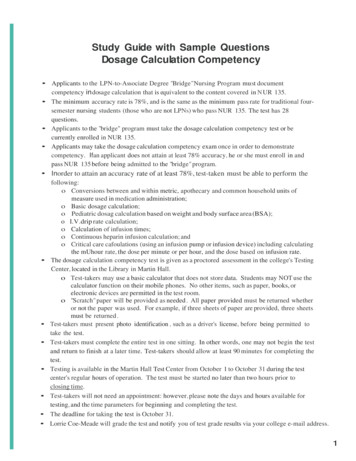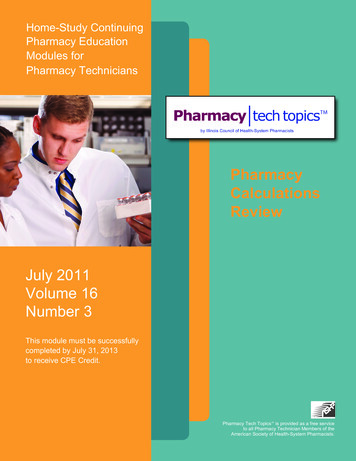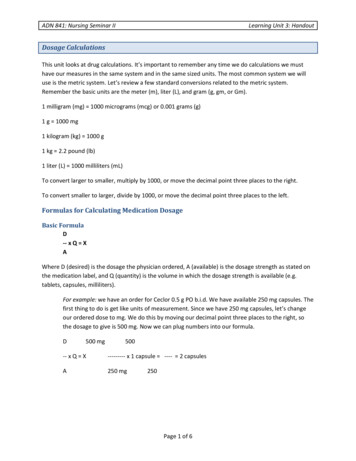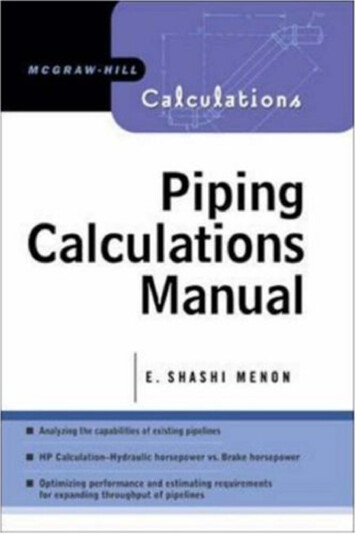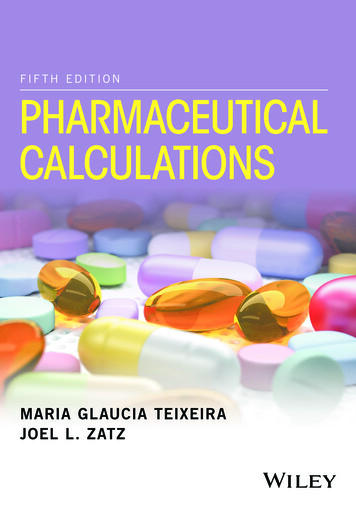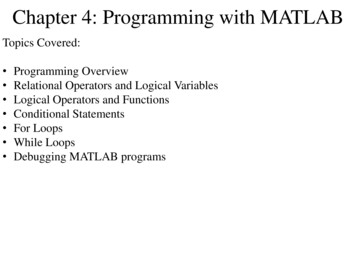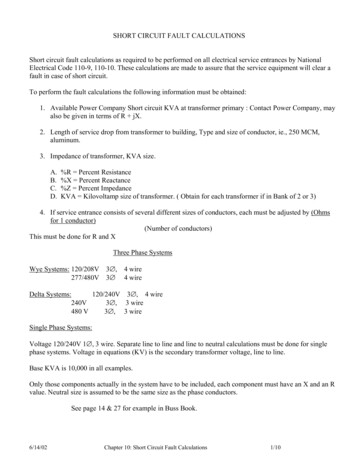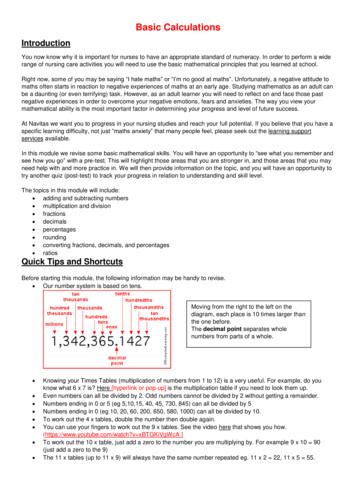
Transcription
Basic CalculationsIntroductionYou now know why it is important for nurses to have an appropriate standard of numeracy. In order to perform a widerange of nursing care activities you will need to use the basic mathematical principles that you learned at school.Right now, some of you may be saying “I hate maths” or “I‟m no good at maths”. Unfortunately, a negative attitude tomaths often starts in reaction to negative experiences of maths at an early age. Studying mathematics as an adult canbe a daunting (or even terrifying) task. However, as an adult learner you will need to reflect on and face those pastnegative experiences in order to overcome your negative emotions, fears and anxieties. The way you view yourmathematical ability is the most important factor in determining your progress and level of future success.At Navitas we want you to progress in your nursing studies and reach your full potential. If you believe that you have aspecific learning difficulty, not just “maths anxiety” that many people feel, please seek out the learning supportservices available.In this module we revise some basic mathematical skills. You will have an opportunity to “see what you remember andsee how you go” with a pre-test. This will highlight those areas that you are stronger in, and those areas that you mayneed help with and more practice in. We will then provide information on the topic, and you will have an opportunity totry another quiz (post-test) to track your progress in relation to understanding and skill level.The topics in this module will include: adding and subtracting numbers multiplication and division fractions decimals percentages rounding converting fractions, decimals, and percentages ratiosQuick Tips and ShortcutsBefore starting this module, the following information may be handy to revise. Our number system is based on tens.Moving from the right to the left on thediagram, each place is 10 times larger thanthe one before.The decimal point separates wholenumbers from parts of a whole. Knowing your Times Tables (multiplication of numbers from 1 to 12) is a very useful. For example, do youknow what 6 x 7 is? Here [hyperlink or pop-up] is the multiplication table if you need to look them up.Even numbers can all be divided by 2. Odd numbers cannot be divided by 2 without getting a remainder.Numbers ending in 0 or 5 (eg 5,10,15, 40, 45, 730, 845) can all be divided by 5Numbers ending in 0 (eg 10, 20, 60, 200, 650, 580, 1000) can all be divided by 10.To work out the 4 x tables, double the number then double again.You can use your fingers to work out the 9 x tables. See the video here that shows you how.(https://www.youtube.com/watch?v xBTGKiVgWcA ]To work out the 10 x table, just add a zero to the number you are multiplying by. For example 9 x 10 90(just add a zero to the 9)The 11 x tables (up to 11 x 9) will always have the same number repeated eg. 11 x 2 22, 11 x 5 55.
Adding and SubtractingRemember .don’t use a calculator!Have a go! lp:To add two numbers together, place one on top of the other with the same face value lining up. If there are decimalpoints present, they should also be lining up. Starting from the number on the right, add the top number and thebottom number. If the answer is 10 or higher (eg 8 7) place the „ones‟ value in the answer section and carry the„tens‟ into the next column. Move left along the numbers until all have been added. Use this same process to add 3 ormore numbers together.To subtract one number from another, you line up the numbers in the same way as you did for addition. Subtract thebottom number from the top number and write the answer below. If the number on the bottom is larger than the topnumber we need to „borrow‟ from the next column. To do this, subtract 1 from the top number in the column to the left.Cross out the number you are borrowing from, subtract 1 and write the new number above it. Then add 10 to the topnumber of the column you are working in. Complete the subtraction in this column and then move to the left,continuing to subtract each column. The decimal point in the answer should line up with the decimal point in thequestion.See this video on adding and subtractingnumbers.https://www.youtube.com/watch?v 0heWxHeRbkYApplication to Nursing:Adding and subtracting numbers are skills used in everyday life as well as in professional practice. For nurses, beingable to add and subtract is especially vital when calculating a patient‟s food and fluid intake compared with output.This application will be covered in detail in Module 2 where we will assess your understanding of how numeracy skillsapply to fluid balance and nutritional status. Meanwhile, consider this scenario, and answer the questions to see if youunderstand the principles of addition and subtraction. Remember that literacy is attached to numeracy. In other words,you need to read and understand the content and questions in order to calculate the correct answers.The Get-well Hospital has the following patient areas and capacity: The surgical ward has 28 beds, the medical wardcan accommodate 32 patients, the ICU has 4 beds, the orthopaedic ward can take 22 patients, and there is a DayProcedure Unit with a capacity to care for 12 patients per day. This unit is open from 0800 - 1800 hrs.a) How many patients can be accommodated in the hospital during the day? How many at night?b) Yesterday morning at 1000 hrs the surgical ward had 7 empty beds, and there were 9 less patients in theorthopaedic ward than the usual „full house‟, and only 8 patients had arrived for their day procedures. Allother areas were at capacity. How many patients were in the hospital at 1000hrs?The Nurse Unit Manager of the surgical ward has been allocated 32,000 to spend on education and training for thecoming year. So far, EN Smith has asked for 1200 to attend a conference, and RN Jones has been granted 2,350assistance to complete her Masters degree. Two other ENs have requested 150 each to attend a 1 day skillscourse. c) How much is left in the training budget for the rest of the year?
Multiplication and DivisionRemember .don’t use a calculatorHelp:ExampleMultiplying by 10, 100, 1000When multiplying by 10, 100 or 1000 the easiest way to calculateis to move the decimal point 1, 2 or 3 spaces to the right.0.42 x 10 4.2(decimal point moved 1 space to the right)Dividing by 10, 100, 1000When dividing by 10, 100 or 1000 the easiest way to calculate is tomove the decimal point 1, 2 or 3 spaces to the left. You can usezeros to make up places when you need to. For number less thanone, write a zero before the decimal point.0.42 x 100 42(decimal point moved 2 spaces to the right)0.42 x 1000 420(decimal point moved 3 spaces to the right):You can add a zero if there is no number asin the example 0.42 x 1000Example36 / 10 3.6 (decimal point moved 1 space to the left)36 / 100 0.36 (decimal point moved 2 spaces to the left)36 / 1000 0.036 (decimal point moved 3 spaces to the atch?v D8qLhPIrw MMultiplying whole numbers and decimalsLong multiplication involves multiplying two or more digits together.Treat each number separately, remembering to put one zero on the farright column when multiplying by tens, and add two zeros whenmultiplying by hundreds. Ignore the decimal point until the end. You canthen count the number of decimal places in your question and apply thesame number to the answer.DividingIn maths, division is denoted by the symbols or / or —. Division is theopposite from multiplication. It involves splitting a number into equalparts.Long division is a versatile method for handling complex divisionswithout using a content/decimals-multiplicationShort Division (by single number)https://www.youtube.com/watch?v 2X0Cjy7oEgwLong Division (by 2 or more numbers)https://www.youtube.com/watch?v eIUoIhfupuAHere is another video that covers allaspects of ntent/decimals-divisionApplication to Nursing:Nurses use multiplication and division skills when calculating fluids to be given to the patient, and when calculatingdrug doses. In module 5 you will practice converting units of weight and volume, medication concentrations andstrengths, and calculating flow rates of intravenous therapy. All of these skills require you to be competent andconfident with basic multiplication and division.Meanwhile, consider the following questions that use basic multiplication and division skillsa) A patient is to receive 2.5 milligrams of a particular medication per kilogram (kg) of body weight. If the patientweighs 79 kg, what dose of the medication is required?b) If one tablet contains 20 milligrams, how many milligrams would 4 tablets contain?c) A baby is to be fed 75 millilitres (mL) every 3 hours. How much is this per day?
d) If a patient is to receive 1000mL of intravenous fluid every 10 hours, how many mL would be given every hour?FractionsRemember .don’t use a calculatorHelp:A fraction (from Latin: fractus, "broken") represents a part of a whole or, more generally, any number of equal parts.When spoken in everyday English, a fraction describes how many parts of a certain size there are, for example, onehalf, one-third, three-quarters.Here are some terms relating to fractions that you need to know:Numerator: the top number of a fractionDenominator: the bottom number of a fractionProper Fraction: the numerator is smaller than the denominator eg 2/5Improper Fraction: the numerator is larger than the denominator eg 5/2Mixed Number: made up of a whole number and a fraction eg 1¼Equivalent Fractions: fractions that look different but express the same thing.eg 1/2 2/4 3/6 10/20 40/801/3 2/6 3/9We can change fractions into equivalent fractions as long as whatever you do to the numerator is also done to thedenominator.Simplifying Fractions: Fractions should always be displayed in their simplest form. To simplify or cancel down afraction, we divide the numerator and the denominator by the same number. The answers must be whole numbers.For larger numbers, it may be easier to use a couple of steps to get the final answer.Example: simplify 12/36. Look for the highest common factor. In this case it is 12 (if you know your 12 x tables!)Therefore, dividing both the numerator and denominator by 12 gives an answer of 1/3. However, you could have usedyour 6 x tables, or divided by 2 twice until the answer was 3/9, then use 3x tables.Multiplication of FractionsTo multiply fractions: Simplify the fractions if not in lowest terms. Multiply the numerators of the fractions toget the new numerator. Multiply the denominators of the fractions to get the new denominatorThis is a great video on fractions.It is 11 minutes long, but very informativeand entertaining:https://www.youtube.com/watch?v 0o32bnoLZaMAdding and Subtracting Fractions:Before you can add or subtract fractions with differentdenominators, you must first find equivalent fractions with the same denominator, like this: Find thesmallest multiple (LCM) of both numbers. Rewrite the fractions as equivalent fractions with the LCM as thedenominator.Application to Nursing:Whilst fractions are not used as much as whole numbers and decimals, nurses still need to know how to work withthem. You will be expected to administer part of an ampoule (glass container) of medication or part of a tablet. If apatient tells you that they ate “three-quarters” of their meal, you need to be able to conceptualise what that represents.
DecimalsRemember .don’t use a calculatorHelp:We have encountered decimals (metric system) already in this module, so you should be familiar with them. How didyou go in the test above?Do you know that fractions or parts of a whole number can also be expressed as decimal numbers?Fractions and decimals represent the same things: numbers that are not whole numbers.Learn the following fractions and their decimal equivalent:1/10 0.11/5 0.21/4 0.251/3 0.33Therefore 6/10 6 x 0.1 0.6Therefore 4/5 4 x 0.2 0.8Therefore 3/4 3 x 0.25 0.75Therefore 2/3 2 x 0.33 0.661/2 0.5If you need to convert a fraction such as 5/8 to a decimal, you will need to perform a short division sum. Refer back tothe section on Division. The answer by the way to this calculation is 0.625. Have a try. You just need to remember thatthe denominator (bottom number) is the number you divide by (known as the „devisor‟). The top number (numerator) isthe number to be divided (known as the „dividend‟).Application to Nursing:It is more usual to convert fractions to decimals than the other way around, because in nursing (in Australia) we usethe metric system when dealing with numbers.Nurses use decimals on a regular basis, for example, during medication administration or when calculating the weightof a patient. Electronic devices such as pumps used to administer medication doses to patients have metriccalibrations which need to be programmed to run at the correct rate to give the patient the correct dose of medication.Medications are prescribed in decimals rather than fractions. For example, a common prescription for the cardiac drugDigoxin is 62.5 micrograms to be taken daily or twice daily.Nurses administer medications from a variety of syringes. Each syringe has calibration marks to show parts of a wholemL, and the nurse must be able to accurately read those calibrations in order to prepare the correct amount ofmedication to administer.
PercentagesRemember .don’t use a calculatorHelp:We use percentages frequently in everyday life. For example, shops advertise discounts on products. These discountsare percentages "Up to 50% off marked prices". Financial institutions quote interest charged to the client on loans, orinterest paid for money invested, as a percentage.But what does it mean? Percent means „part of a hundred‟. For example, 40 percent (expressed as 40%) means 40out of 100. 100% is actually 100/100.Video on PercentagesTo calculate the % of an amount:If you know how to calculate 10% and 50% of a number, you e able to find the whole number percentage.ent/percentagesTo find 50%, simply halve the number (divide by 2), and to find 10%you divide by 10 (move decimal point one place to left).To find 1%, divide by 100 (move decimal point 2 places to the left)This knowledge can then be used to find other amounts. For example, 20% is double 10%, 5% is half of 10%.Example: Find 25% of 90: First calculate 50% of 90 ( 45), then halve again to find 25%. The answer is 22.5.Example: Find 12% of 60. First calculate 10% ( 6). Then find 1% ( 60/10 0.6). Now add together the parts: 10% 1% 1% 12%. The answer is 6 0.6 0.6 7.2An alternative method: multiply the amount by the percentage. For example: find30% of 150 150/1 x 30/100 450/10 45Here is another example: Find 80% of 180. 180/1 x 80/100 144Changing decimals and fractions into percentages will be covered later on.Application to Nursing:Percentages are useful as they can give significance to a number. They can also be useful when makingcomparisons. Many medical research articles state their findings as percentages of the total number of peopleinvestigated. For example “97% of patients reported having no side effects from the medication being trialled”.The components of medications and fluids are frequently expressed as percentages. For example, a lotion maycontain a certain percentage of active ingredient (eg 0.5% cortisone), and an intravenous (IV) flask may contain 5%dextrose or 0.9% sodium chloride.If a patient is being given Oxygen, the amount of Oxygen is expressed as a %. When breathing in atmospheric air, weare taking in 21% Oxygen. The rest (79%) is made up of Nitrogen and other gases. However, we can give the patientsupplemental Oxygen via a face mask or other device. This can be from around 24% (minimal) right up to 100% for acritically ill patient on full life support.There are quite a few more examples of percentages being used in healthcare and nursing activities, and some ofthem will be discussed in later modules.Meanwhile, consider these scenarios and calculate the answera) A patient is to receive IV fluids over 8 hours. What % would be administered after 6 hours?b) How long would it take to administer 50% of the IV fluid in the above scenario?c) If a patient was being given 55% Oxygen, what would be the amount of room air they would be breathing in?
RoundingHelp:We often „round‟ numbers that have decimal points to make them more manageable.When we round to a decimal place, we are talking about the amount of numbers that come after the decimal point (tothe right of the decimal point).When we round numbers, we round the number down if the number we are removing is between 1 and 4. We roundthe number up if the number we are removing is between 5 and 9.When answering questions relating to rounding, make sure you readand note the required number of decimal places.Video on Roundinghttps://www.youtube.com/watch?v ARhxT5WyWcApplication to Nursing:When a calculation for medications or intravenous therapy results in a number with decimal places, whether thenumber is rounded to a whole number or to 1 or 2 decimal places will depend on the situation.Basic fluid infusion devices (“pumps”) can only be programmed to deliver millilitres (mL) per hour. It has to be a wholenumber. If the IV therapy order is for 1000mL over 24 hours, the calculation of mL/hour comes to 41.666. Rounding upto a whole number means that the pump will need to be set to deliver 42 mL per hour.When drawing up liquid medication into a syringe, the amount is normally rounded to 1 decimal place if the syringehas appropriate calibration marks. For paediatric (children‟s) doses, the volume of medication is usually rounded to 2decimal places to ensure the most accurate dose of medication.
Converting Fractions, Decimals, and Percentages,Help:By now you should be confident when dealing with fractions, decimals, and percentages. Decimals are really justfractions with a denominator that is limited to a multiple of 10. (ie 10, 100, 1000 etc). Percentages are also a specialkind of fraction, but this time the denominator is always 100. Remember, percentages are „parts of 100‟ anddesignated by the symbol %. These 3 values can be converted from one to another quite easily.Examples: Change this decimal to a percentage:1. Express 0.65 as a %Multiply by 100 (move decimal place 2 places to right)and add % symbolie 0.65 x 100 65%2. Express 0.275 as a %0.275 x 100 27.5%Video: if you need further assistance withthese conversionshttps://www.youtube.com/watch?v lOmv-M2jKDUPercentage to Decimal: Divide by 100 and remove % symbol (move decimal point 2 places to left)Fraction to Decimal: Divide the numerator by denominator. eg 2/3 0.666Percent to Fraction: Divide the percentage figure by 100. Simplify the fraction if possible.Decimal to Fraction: Divide by10, 100, or 1000 depending on how many decimal places. Simplify the resultingfraction. eg 0.3 3/100.12 12/100 6/50 3/250.158 158/1000 79/500Fraction to Percent: can convert first to decimal and then multiply x 100, or simply multiply the fraction by 100 if itappears that it will cancel down to a whole number. Add a % symbol to the answer.Application to Nursing:Nurses need to be confident when these terms are used and to recognise equivalency. The ability to analyse andunderstand the conversion methods will enhance critical thinking skills. In later modules when we start calculatingmedication doses and IV fluid infusion rates, this ability will stand you in good stead.
RatiosHelp:Ratios are used when you want to compare the relationship of one quantity to another. This is expressed using thesymbol : between two or more quantities. We use ratios in our everyday lives eg the perfect vinaigrette salad dressingconsists of 1 part vinegar to 3 parts oil. This is expressed as 1:3. It could also be expressed as 3:1 providing it is clearthat for every 3 quantities (eg 3 tablespoon) of oil you need to use 1 quantity of vinegar (1 tablespoon). Of course ifyou wish to make more salad dressing you need to increase the amounts of ingredients in the same proportions.Remember: the order of the numbers is important, 3:2 means something different to 2:3.Ratios are used when calculating distances to travel and the speed (rate) ofthe vehicle and other such calculations. See the video for an explanation.Many professionals and industries use ratios and proportions in their work,from Accountants to Landscapers and Interior Decorators.Ratios can also be expressed as fractions, decimals, and percentages.For example, if you have 3 dogs and 1 cat, you could write this ratio as:Videos on Ratioshttps://www.youtube.com/watch?v rpci5WLykVUhttps://www.youtube.com/watch?v 0oaYMKwF7sI3:1 (for every 3 dogs, there is one cat)3/4 are dogs and 1/4 are cats (don‟t forget to include total number for fractions)0.75 are dogs and 0.25 are cats75% are dogs and 25% are catsConsider the following TableScenarioThere are 4 apples and 5 bananasThere are 3 women and 3 menThere is one RN and 3 ENsThere are 9 sausages and one steakRatio4:53:3 1:11: 39:1Fraction4/9 are apples and 5/9 bananas3/6 ½ are women and ½ men¼ are RNs, ¾ are ENs9/10 are sausages, 1/10 steakDecimal0.44 apples, 0.56 bananas0.5 are women, 0.5 men0.25 are RNs, 0.75 ENs0.9 are sausages, 0.1 steakApplication to Nursing:There are numerous situations where ratios are used in nursing. The nurse to patient ratio is a common topic ofdiscussion in the literature because of poor staffing levels in some healthcare facilities. Nursing industrial bodiesadvocate a 1: 4 ratio to maintain patient safety in acute care hospitals. Some residential facilities may have a 2: 40 ( ie1:20) ratio of nurses to clients/residents. For each nurse on duty there are 20 residents to care for.The ratio of RNs to ENs to Care Assistants on the roster is another consideration.Some drugs are expressed as a weight to volume ratio (such as the emergency drugs adrenaline and noradrenaline).These could be expressed as 1:1,000 or 1:10,000. The expression is similar to a percentage except that the weightremains constant (1g) and the volume differs. The volume is in millilitres. Therefore: Adrenaline 1:10,000 1g in 10,000ml; Noradrenaline 1:1,000 1g in 1,000ml.Medication calculations and concentrations of medications in solutions arebased on ratios. We will be looking at these in another module.Meanwhile, use your knowledge of ratios and proportions to answer thefollowing questions:a) Ellen and Jill have accumulated a 24 years of nursing experience, in aratio of 1:5. How many years‟ experience does each have?b) In the Get Well Hospital the ratio of RNs to ENs is 3:2. If there are 24RNs, how many ENs are employed in the hospital?c) The pass rate for an exam for the last 3 groups of nursing students isexpressed in the following ratio; 5:4:3. A total of 360 students passedthe exam. How many were successful in each group?
For nurses, being able to add and subtract is especially vital when calculating a patient‟s food and fluid intake compared with output. . The surgical ward has 28 beds, the medical ward can accommodate 32 patients, the ICU has 4 beds, the orthopaedic ward can take 22 patients, and there is a Day Procedure Unit with a capacity to care for 12 .


